April 27, 2020
History Guide to Schönbrunn Palace Gardens, Zoo & Monuments, Vienna
Architecture, Culture, Guide, History, Tour
Top attractions:
Quick Navigation
The Summer Residency of the Habsburgs
Built between 1743 and 1779, Schönbrunn Palace and its gardens could be easily single-outed as the crown jewel of the whole history of the Austrian Empire. The beauty and the richness of Schönbrunn Gardens might seem like a symbol of absolute imperial authority but it was opened to the public in 1779 – just a year later after the last major monument was finished in the park.
Ever since, the gardens became a beloved place of Viennese and visitors of the Capital City. Every year many tourists come here to witness the luxurious summer residence of the Emperors but I believe many of them miss the mark of this historical landmark. Schönbrunn is not simply the wealth symbol of the Austro-Hungarian Empire but rather of its rich history. While wandering around in Schönbrunn Gardens, one will encounter many monuments symbolizing the cultures, on which the Habsburgs’ Empire was built on.
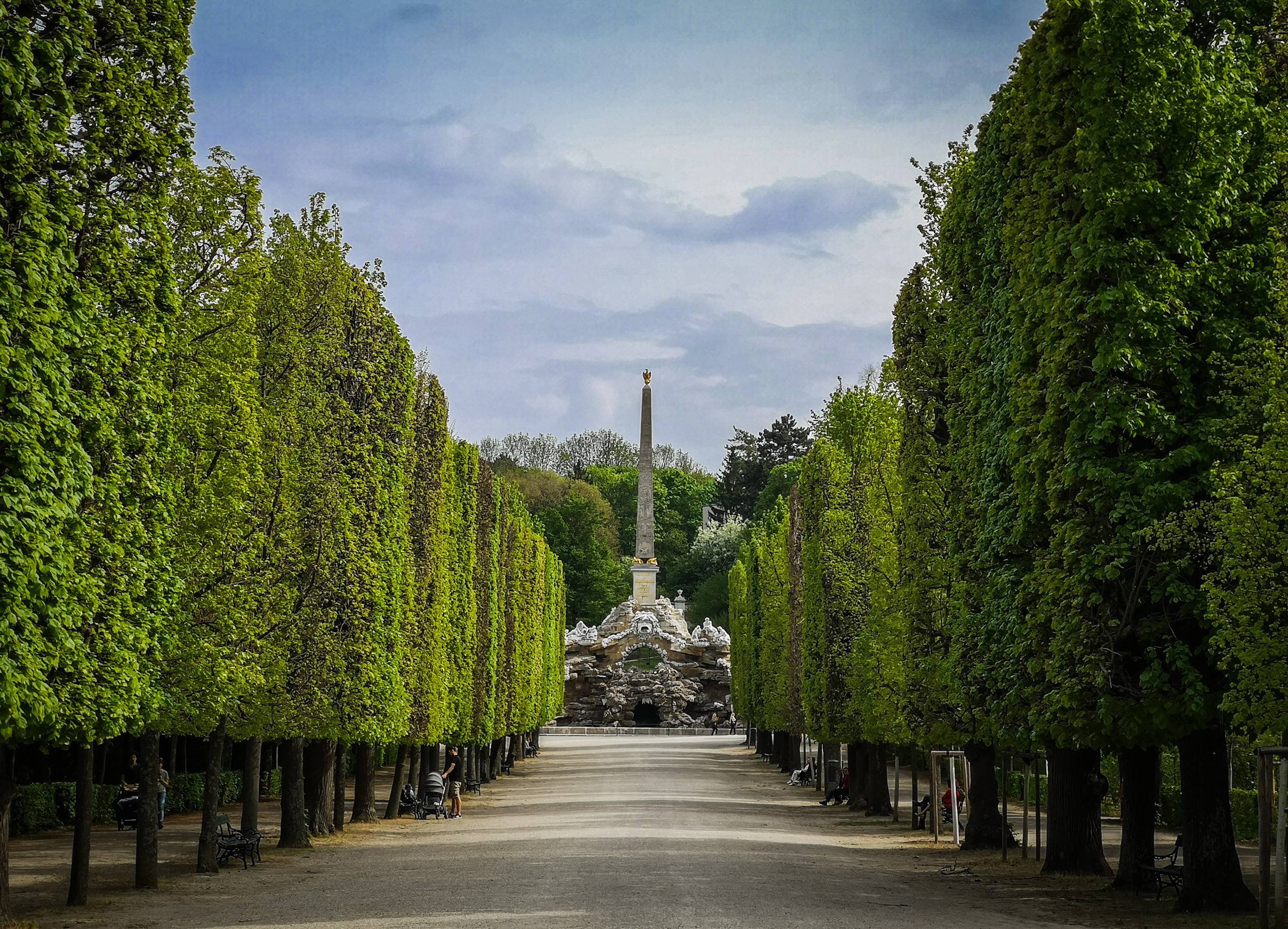
All the monuments within Schönbrunn are connected by magnicifent avenues. Photo by Alis Monte [CC BY-SA 4.0], via Connecting the Dots
Schönbrunn Details
- Location: Hietzing, Vienna
- Coordinates: 48°11′04″N 16°18′43″E
- Dynasty: House of Habsburg
- Built: 1745
- Architectural style: Rococo
- Architects: Johann Bernhard Fischer von Erlach & Nicolò Pacassi
- Area: 186.28 ha
- UNESCO World Heritage Site: 1996
- Entrance fee: Most of the gardens could be accessed for free
- Opening Hours: Mo-Su 06:30-08:00
- Best time to visit: April-May
- Best place to stay: Innere Stadt, Hietzing & Mariahilf
- Hotels nearby Schönbrunn: Austria Trend Parkhotel Schönbrunn Wien, Radisson Blu Park Royal Palace Hotel & Austria Trend Hotel Zoo Wien
Schönbrunn Map
History Tours to Schönbrunn
There are quicker ways to learn about the history of Schönbrunn Palace and its majestic gardens. Why won’t you try joining a guided group tour to Schönbrunn and Schlosspark? I bet these guides can tell even more history stories and legends of Schönbrunn and the residents of the palace. Check these top history guides to Schönbrunn:
- Schönbrunn Palace & Gardens: Skip-the-Line Guided Tour (2-3h | € 36/person)
- Half-Day History Tour of Schönbrunn Palace (2h30-3h | € 79.67/person)
- Skip the Line: Schönbrunn Palace & Vienna City Tour (3h30 | € 54/person)
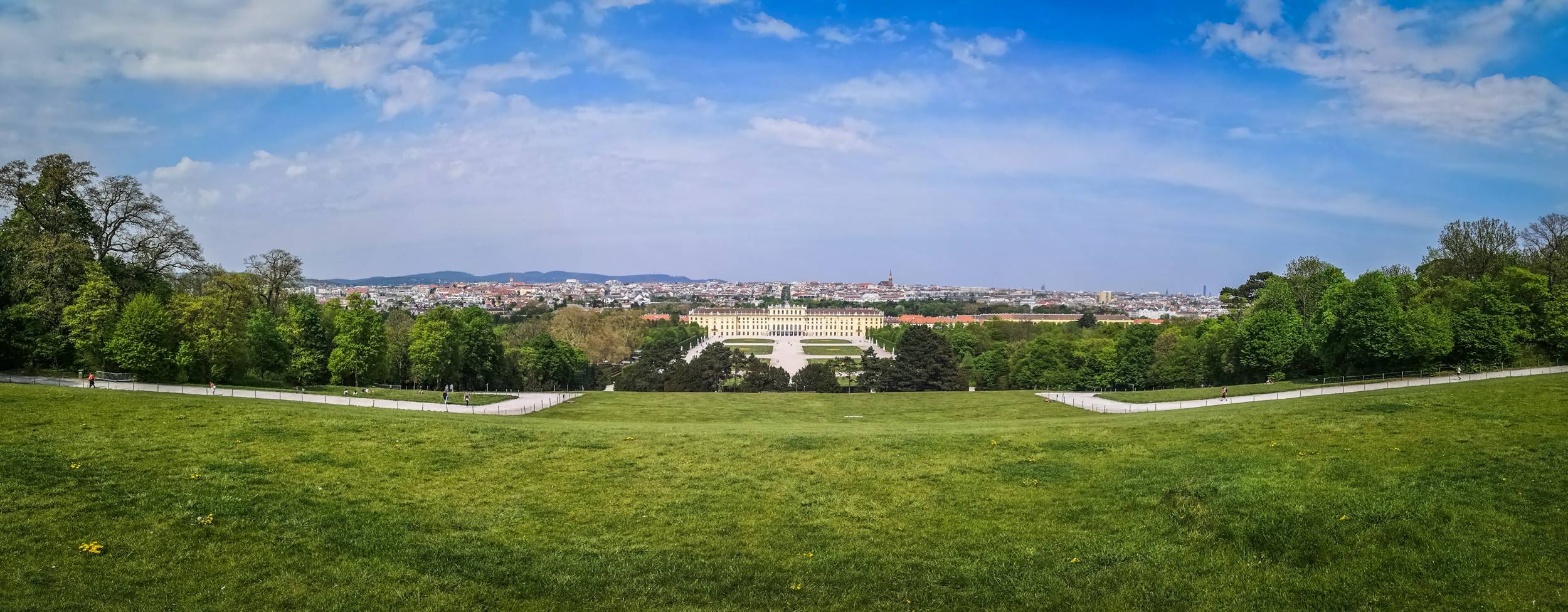
Schönbrunn Palace and the panorama of its gardens from the Gloriette. Photo by Alis Monte [CC BY-SA 4.0], via Connecting the Dots
Katterburg (1548)
The history of Schönbrunn’s location goes even deeper into the past than the Royal residence. By that, I don’t mean the Roman Ruins or other Hellenistic monuments found in the gardens but the previous owner of the land, who had a mansion built here in 1548 known as Kattenburg. The same name was used even before, a mansion in one or another form been here, at least since the 14th century.
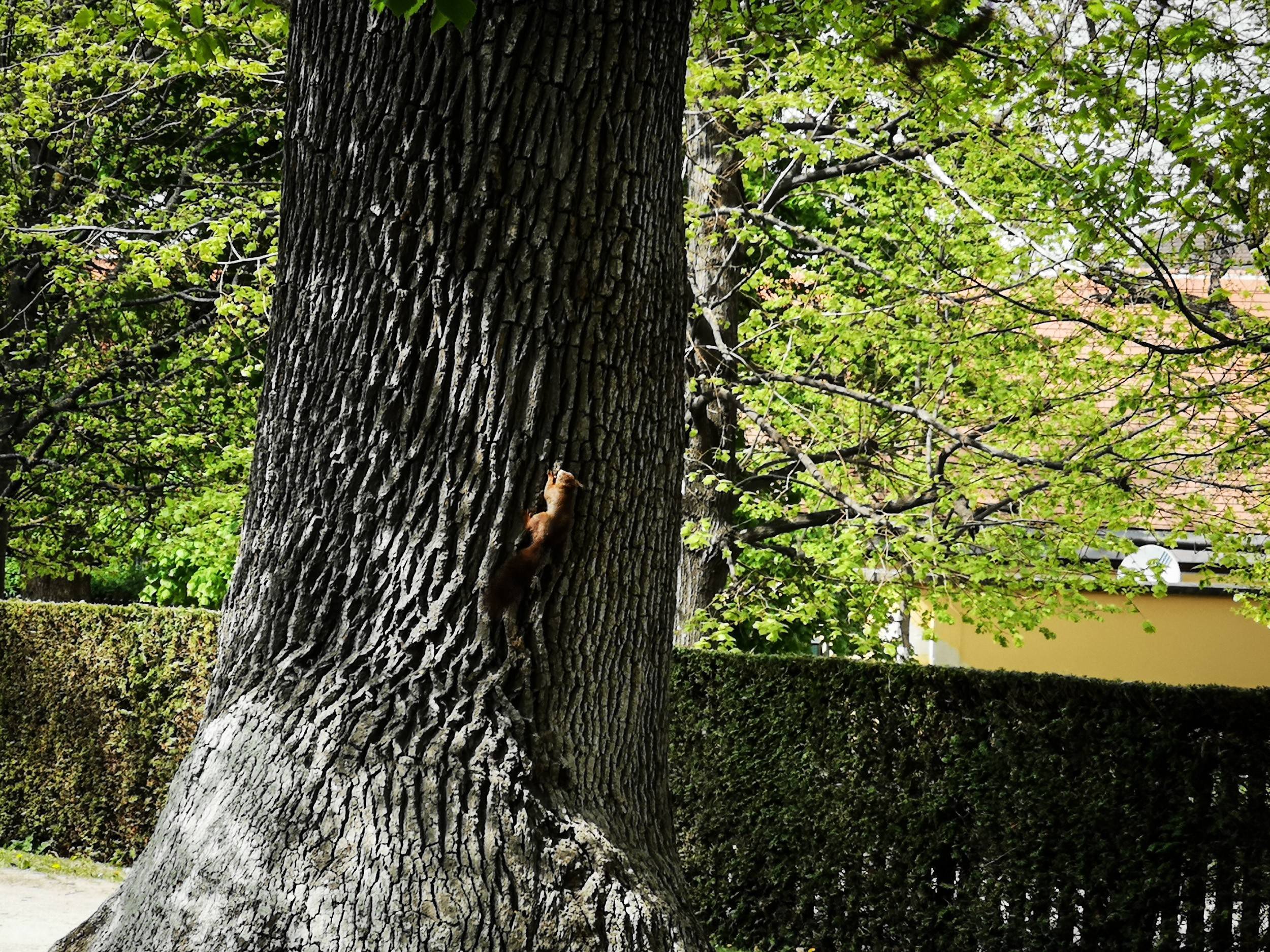
I never visited Schönbrunn without meeting a squirrel. Photo by Alis Monte [CC BY-SA 4.0], via Connecting the Dots
Royal Hunting Grounds (1569)
I cannot say if Kattenburg owner sold the land willingly, or simply the Emperor found it as something he wants to buy but in 1569, The Holy Roman Emperor Maximilian II purchased the land and ordered it to be fenced and put with the game.
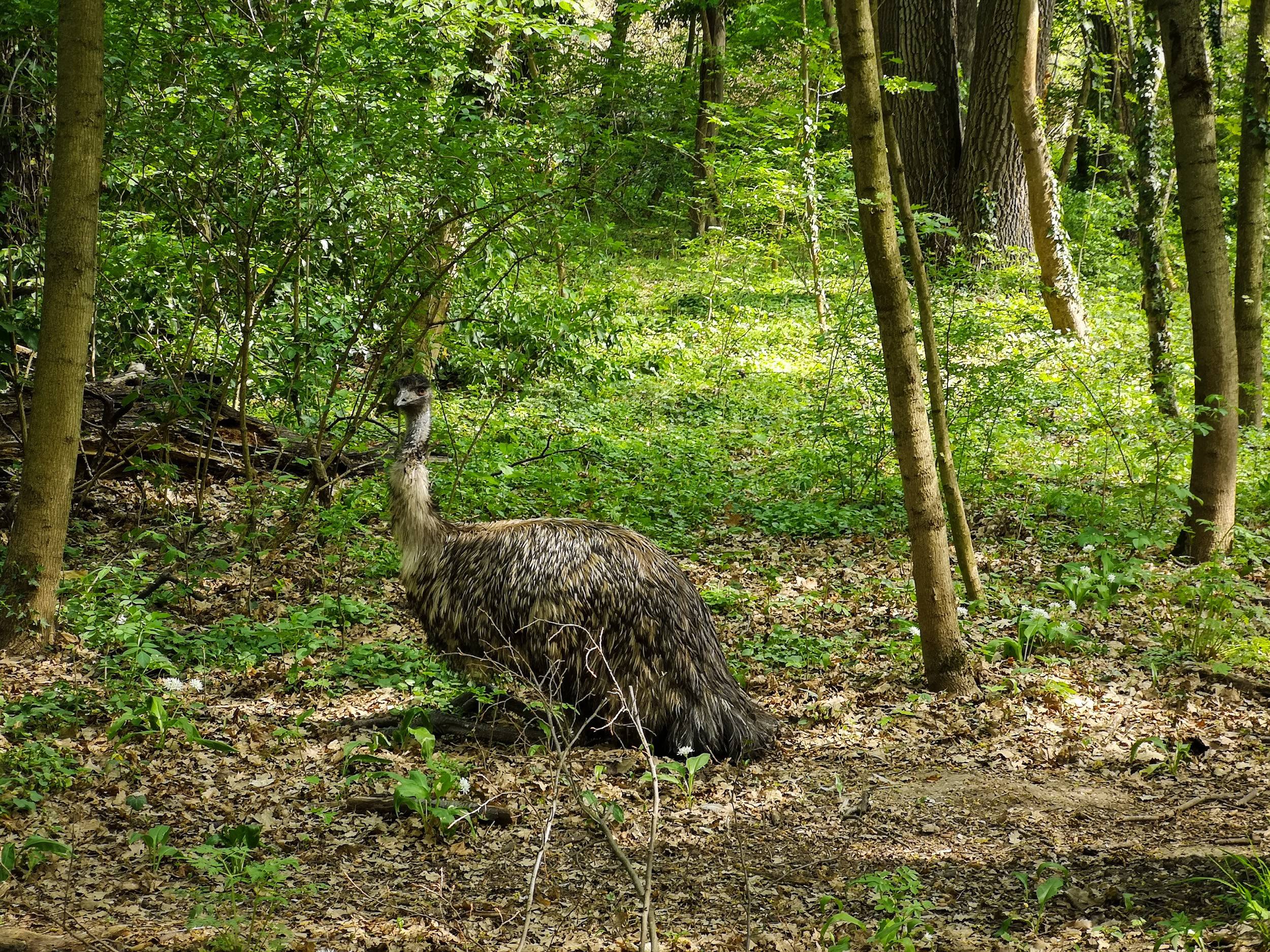
Emu could be seen by all visitors of Schönbrunn. Photo by Alis Monte [CC BY-SA 4.0], via Connecting the Dots
Though nothing like now, the area also had some areas for keeping beautiful peacocks and turkeys, as all the cool kids did in such residences back then.
The Kattenburg mansion and its Gardens were destroyed in 1605 by Hungarian forces. It was soon rebuilt, once Matthias overthrew his older brother, the Holy Emperor Rudolf, which ended the Hungarian revolt.
The Legend of Schöner Brunnen
For a while, Kattenburg served explicitly as hunting grounds, used only by Emperor Matthias himself. This intimate relationship with the territory was a perfect storm for the legend to be born. It is said that on one of such hunting excursions in 1611, Emperor Mathias found a beautiful spring (Schöner brunnen). Maybe he used to tell this story to his children, who were later inspired by it and named the new residence Schönbrunn.
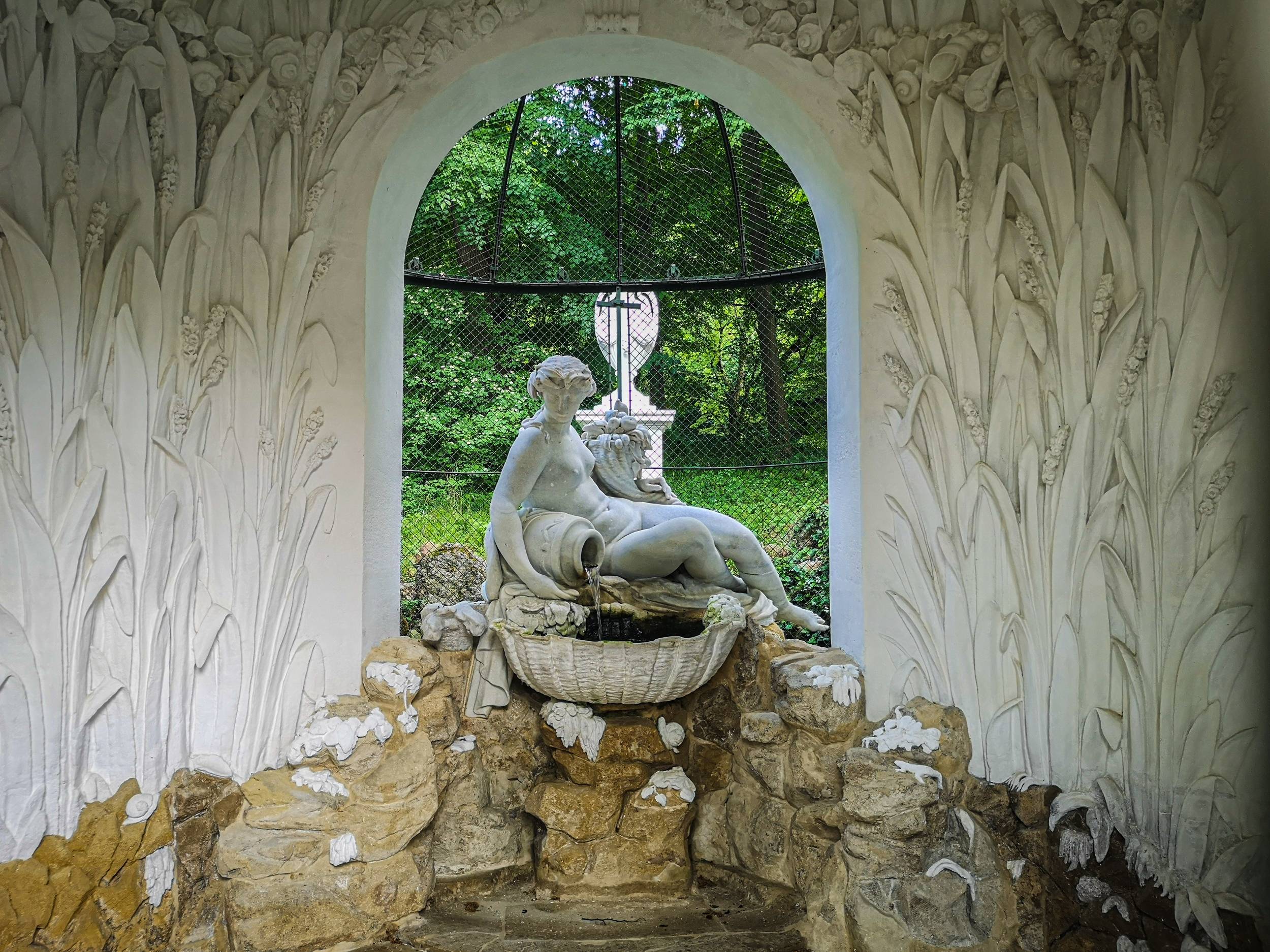
The original or not but there is Schöner Brunnen in Schönbrunn Gardens. Photo by Alis Monte [CC BY-SA 4.0], via Connecting the Dots
Schönbrunn Palace (1742-63)
During the next century, Schönbrunn was passed down into possession from one Habsburg generation to another, and every single one of them added something personal to the palace and its gardens.
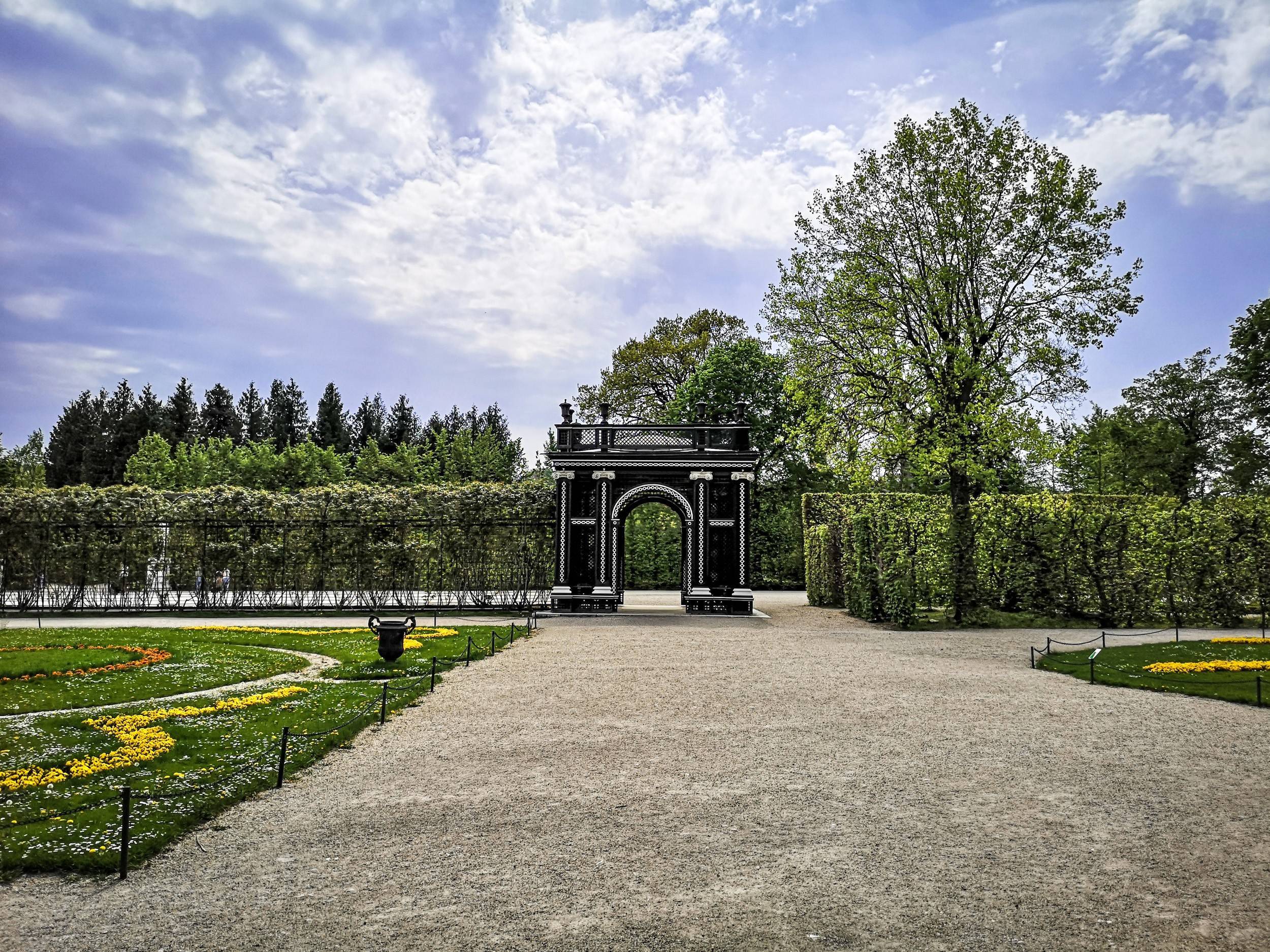
The beautiful garden gates are just one out of many “small” details, making the whole park as glorious and majestic as it is. Photo by Alis Monte [CC BY-SA 4.0], via Connecting the Dots
Unfortunately, Schönbrunn was completely devastated in 1683 during the Siege of Vienna but it didn’t take much time until the palace rose again. All thanks to Maria Theresa, who received Schönbrunn as a gift from her father, Emperor Charles VI.
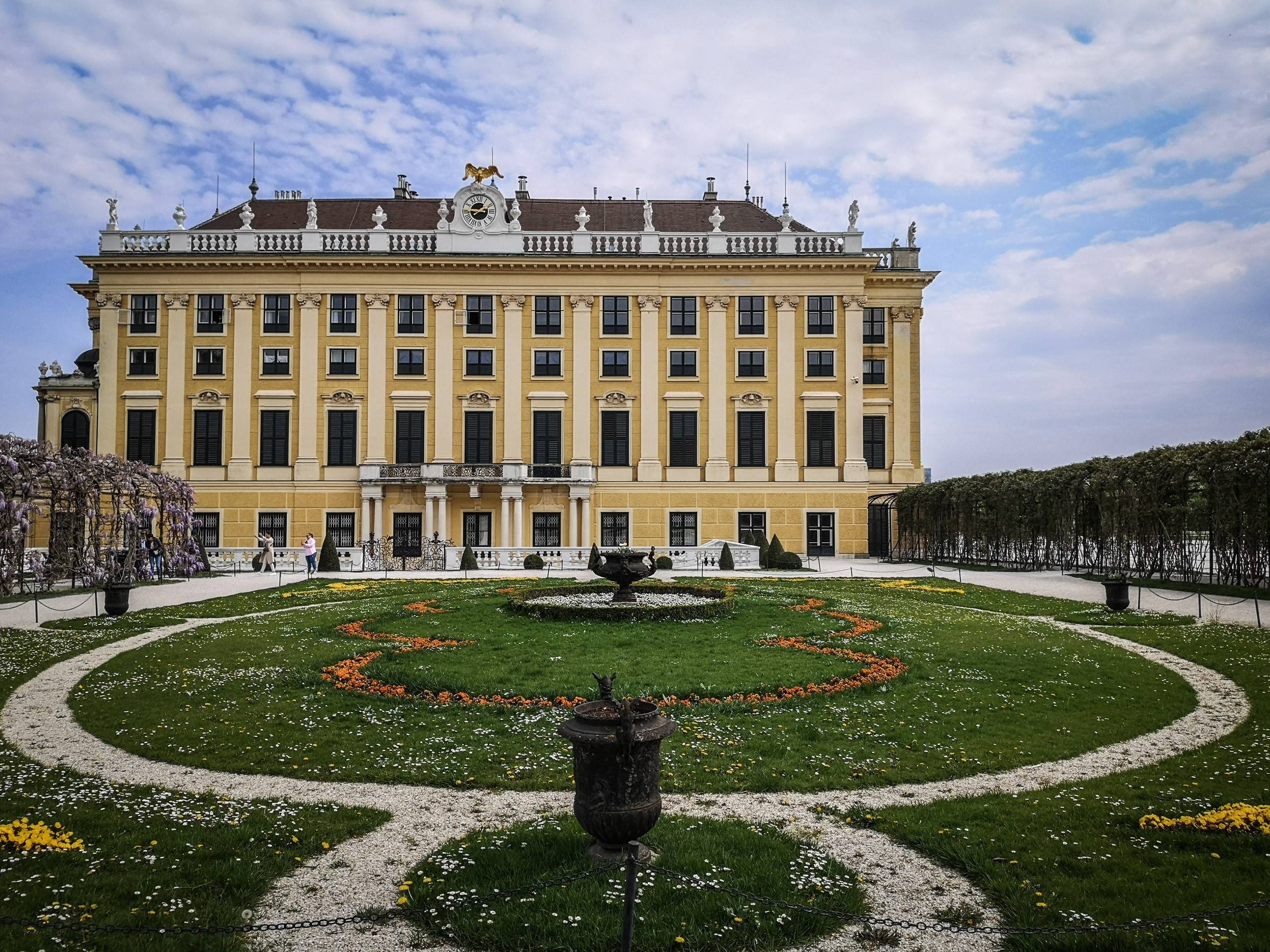
Schönbrunn Palace is surrounded by the magnicifent symmetrical gardens. Photo by Alis Monte [CC BY-SA 4.0], via Connecting the Dots
Throughout her life, Maria Theresa held a great affection for the palace and cherished its gardens. It was under her supervision, when Schönbrunn finally got its current form. The first phase of work, converting the hunting lodge into the palace, started in 1742/43, and soon after in 1745 Schönbrunn became the summer residence of the Imperial family.
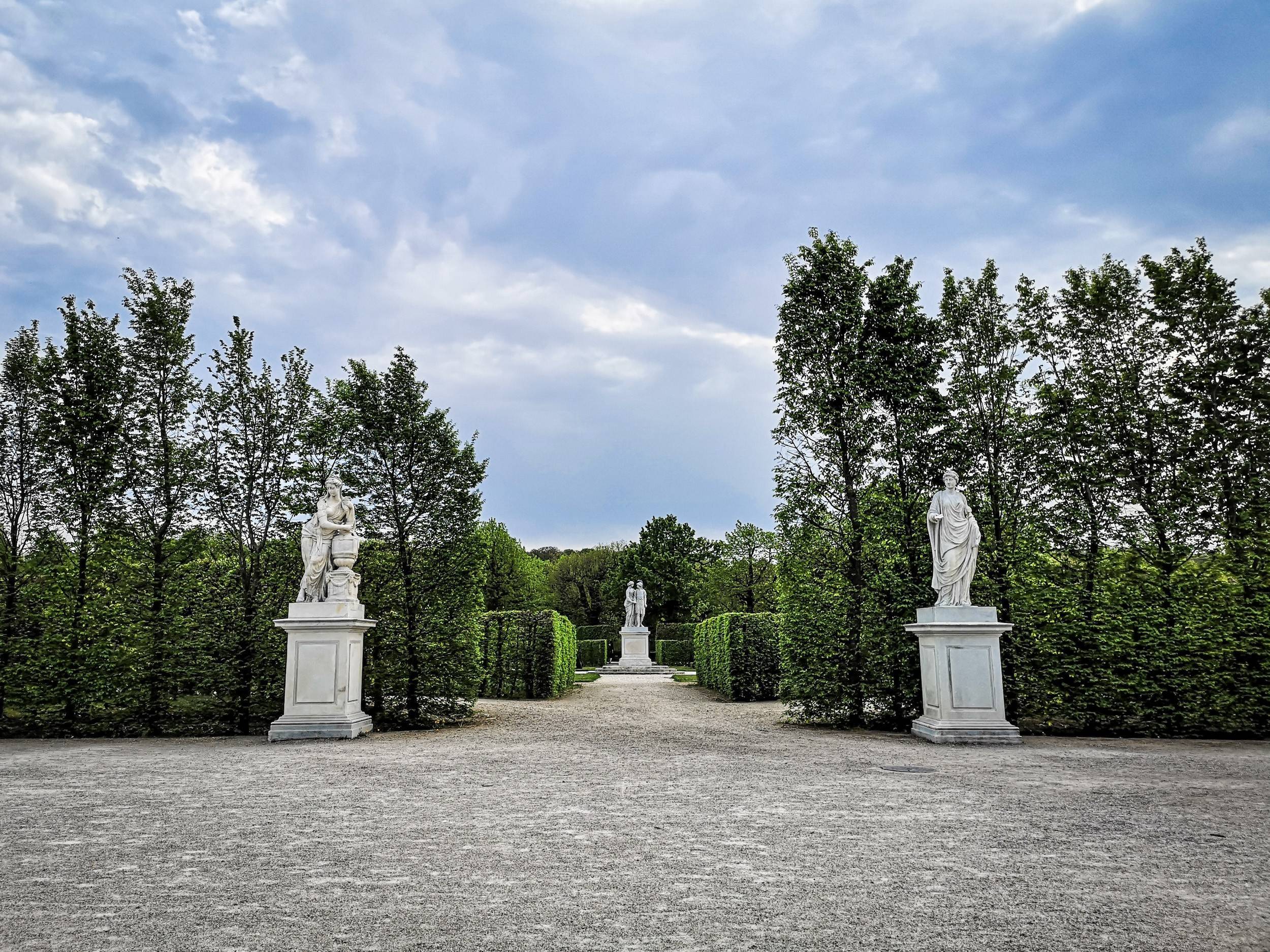
Schönbrunn gardens are full of statues of Hellenic Heroes. Photo by Alis Monte [CC BY-SA 4.0], via Connecting the Dots
The first phase ended until 1750 but soon after, Maria Theresa felt compelled to improve the designs even further. From 1753 to 1763, the execution of works on Schönbrunn was given to Nicolò Pacassi.

The final version of Schönbrunn Palace was built under the rule of Maria Theresa. Photo by Alis Monte [CC BY-SA 4.0], via Connecting the Dots
The Columbary (1750)
The first Columbary, to be more precise – dovecote, at the spot was erected between 1750-55, just years after the palace. Why the rush? Believe it or not but back in the days’ pigeons were kept for their eggs, while peacocks and turkeys were roaming around as decorations. Later on, chickens replaced pigeons because it was easier to keep the flightless birds.
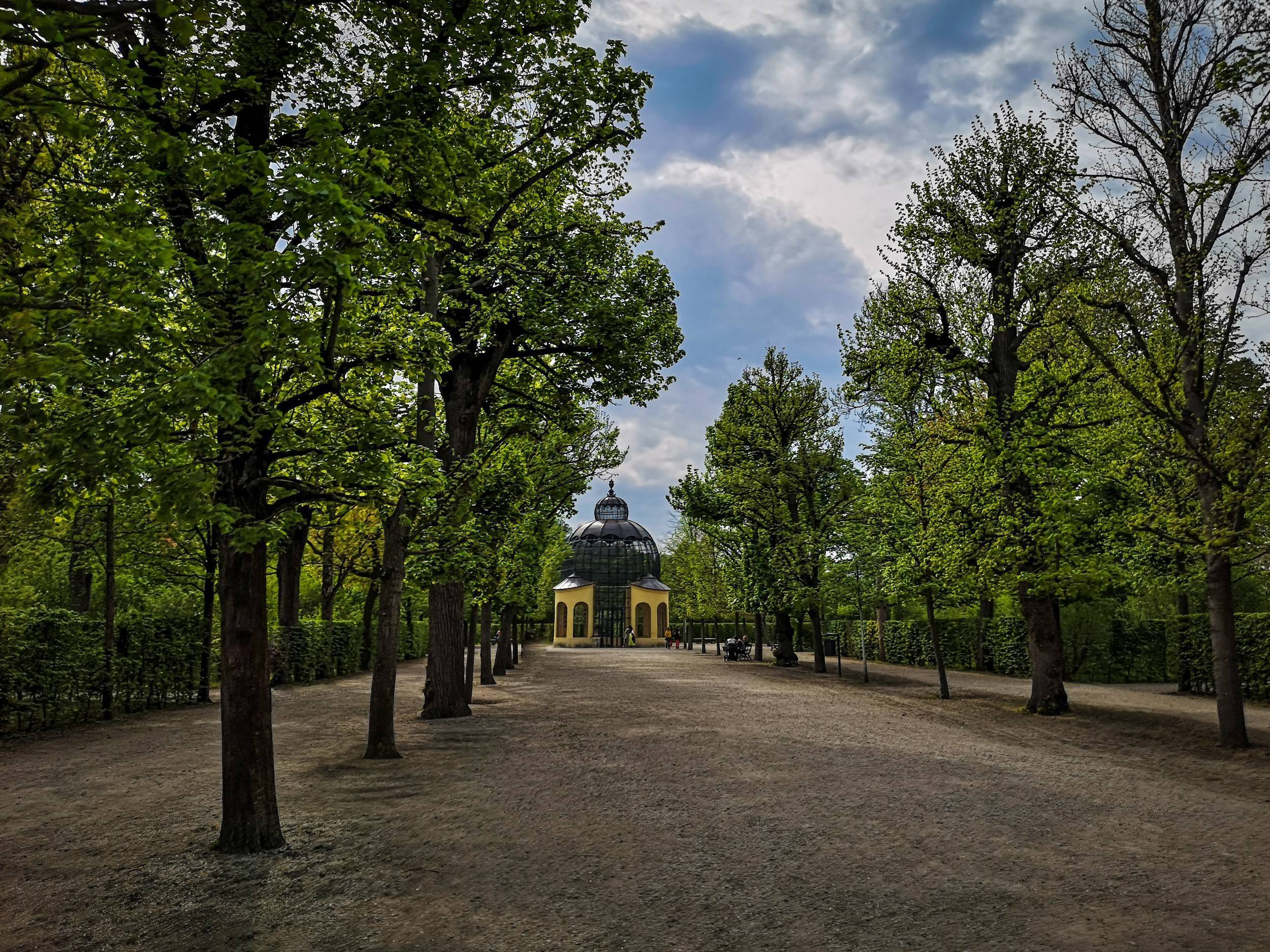
Traditionally the Columbary is also known as ‘Schönbrunn Merry-go-round’. Photo by Alis Monte [CC BY-SA 4.0], via Connecting the Dots
The Columbary and the surrounding gardens got its current shape somewhere until 1776. Its Bosket got its symmetrical form in 1760 and around 20 years later a row of trees surrounding the dovecote was added. Due to its geometrical shape, The Columbary is traditionally known as ‘Schönbrunn Merry-go-round’. Uninteresting as it is, the dovecote has more reason to stand here than the Roman Ruins.
Schönbrunn Zoo (1752)
Other than everything else in Schönbrunn, the zoo and botanic garden were founded by Emperor Franz I Stephan, not by his wife, Maria Theresa. He had a profound interest in natural science and considered himself as an amateur scientist. Despite his titles, the Emperor had probably a lot of free time, so the needs for hobbies.

Emperors used to eat their breakfast in the Central Pavilion surrounded by the exotic animals. Photo by Alis Monte [CC BY-SA 4.0], via Connecting the Dots
As the eldest surviving child of Charles IV, Maria Theresa was the de facto ruler of the entire Empire and the last real of the House of Habsburg. The dynasty continued as the Habsburg-Lorraine dynasty as Emperor Franz I Stephan was originally Duke of Lorraine.
Originally, Schönbrunn Zoo was only a menagerie with only 13 animals, who lived in enclosed areas, surrounding the central pavilion, which was not built until 1759. Currently, Schönbrunn Zoo is the oldest operating Zoo in the world. Though it was started as an amusement for the Emperor during his breakfast time, today it proudly announces itself as a science-oriented zoo, focusing on species preservation and people education.
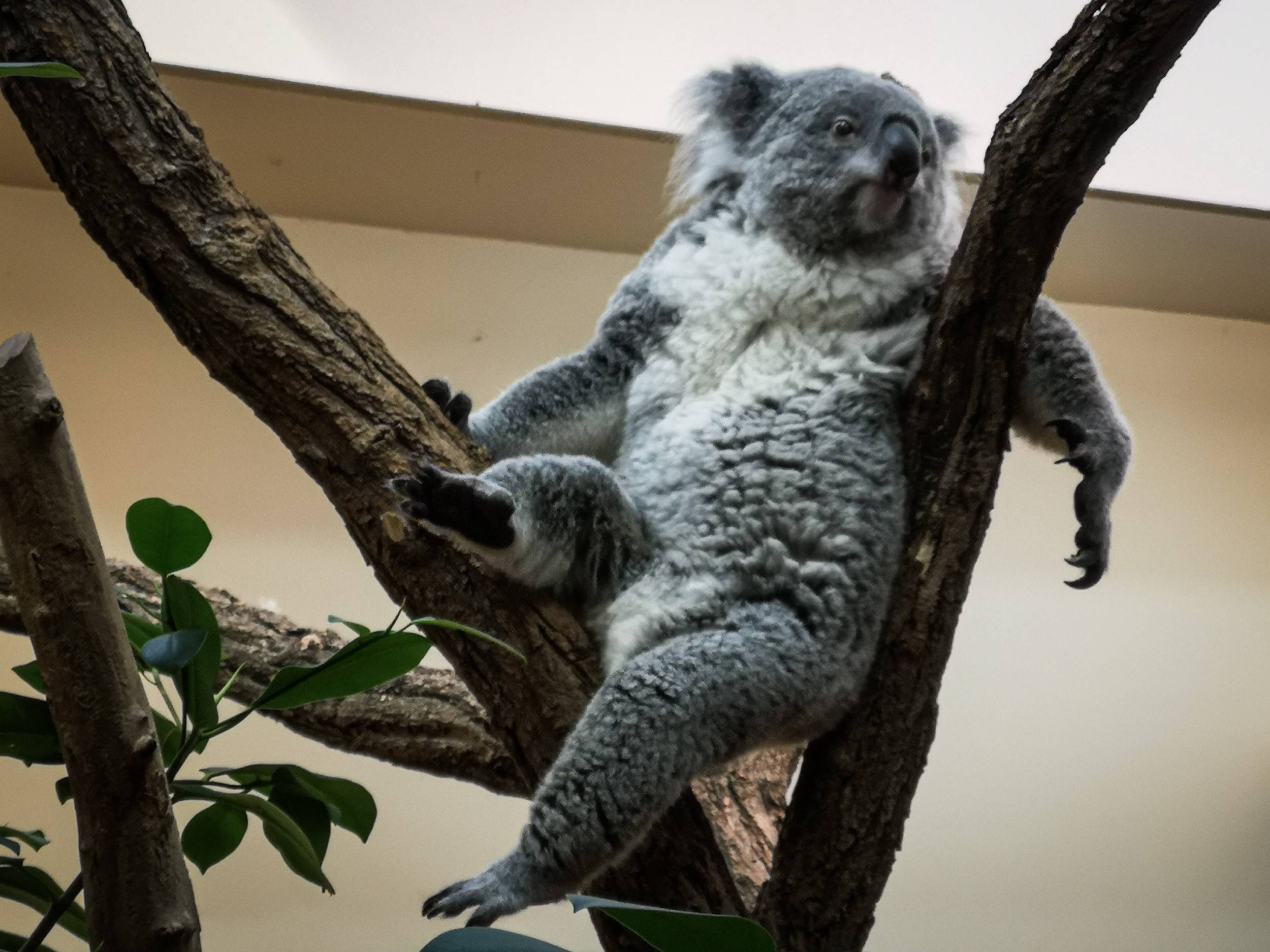
She doesn’t look too stressed, isn’t she? Photo by Alis Monte [CC BY-SA 4.0], via Connecting the Dots
Botanic Garden (1753)
Though the area of Schönbrunn is not entirely that small, Emperor Franz I Stephan had to buy some land from the nearby village of Hietzing to make a Dutch botanic garden out of it. Maybe Maria Theresa was not so fond of her husband’s hobbies, or maybe she had it all planned in her mind for the original territory of Schönbrunn.
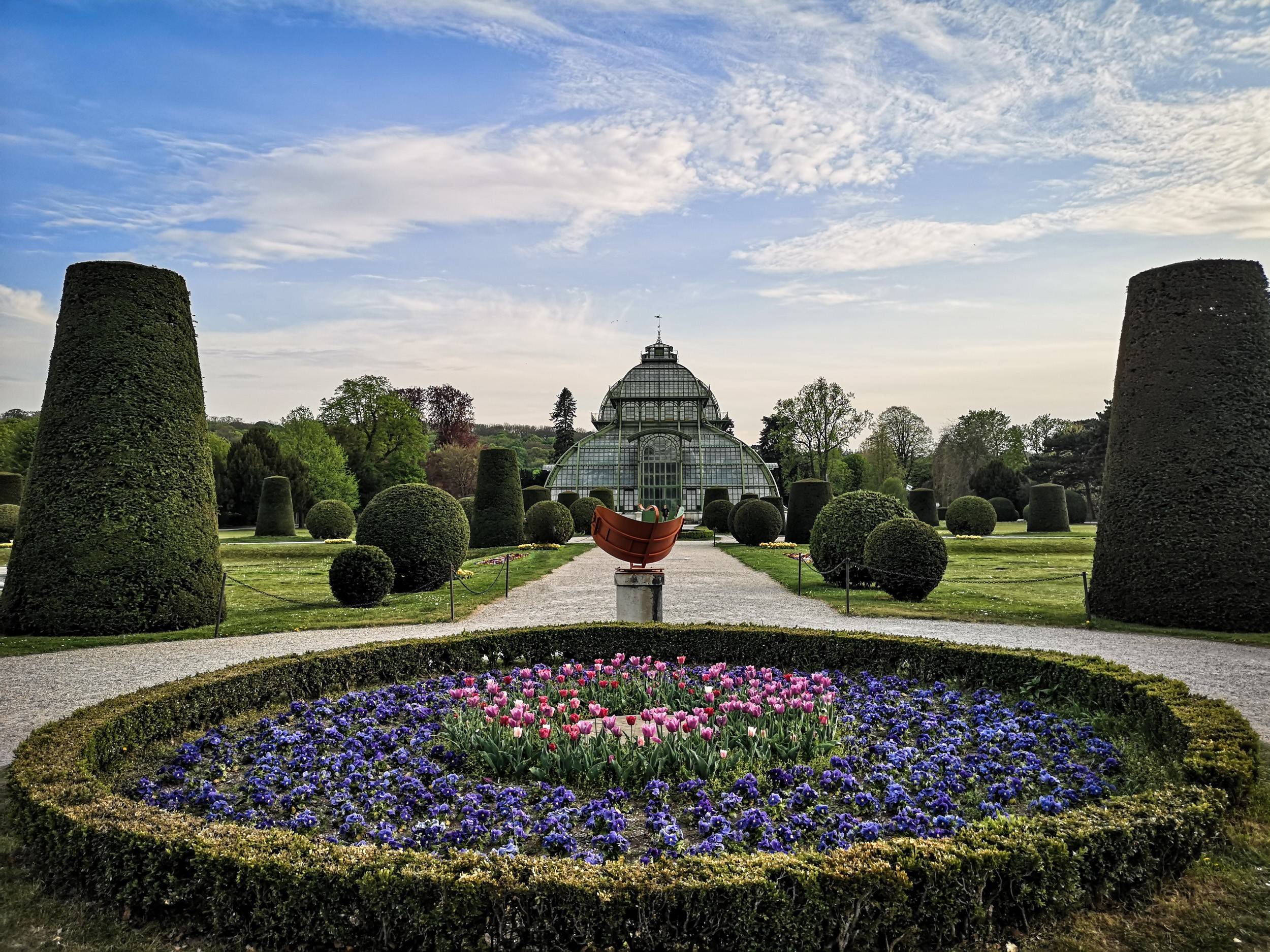
Palm House and Botanic Garden are built on land bought of Hietzing. Photo by Alis Monte [CC BY-SA 4.0], via Connecting the Dots
One way or another, this tradition continued and during the reigns of her son, Emperor Joseph II, and their grandson, Emperor Franz II more land from the village of Heitzing had to be bought to extend the Botanic garden of Schönbrunn.
Today the botanic garden consists of the Palm House, the Desert House, and the Orangery, near which four mighty plane trees could still be found from the times of Emperor Franz II.
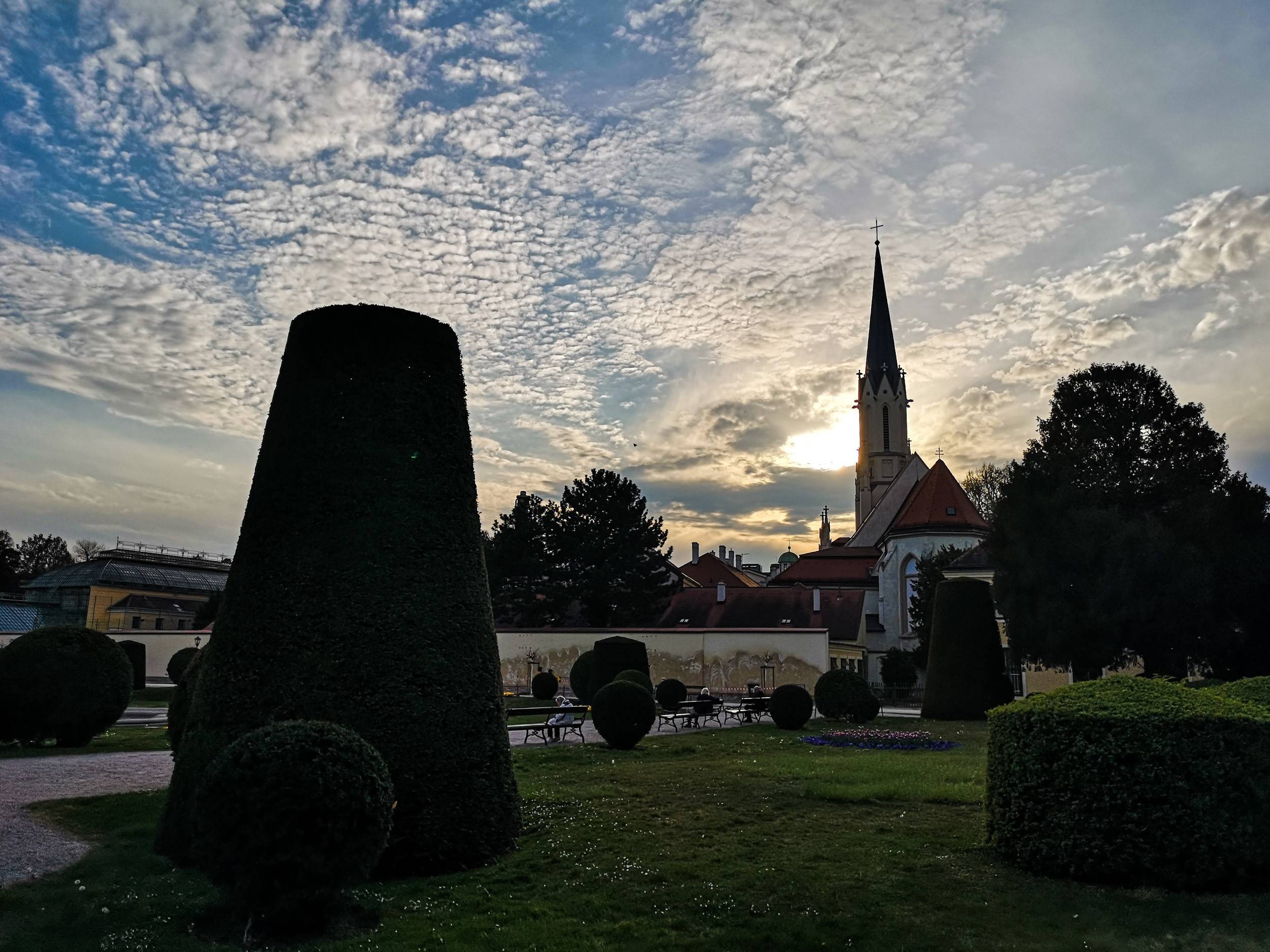
Sunsets from the Botanic Garden are simply stunning. Photo by Alis Monte [CC BY-SA 4.0], via Connecting the Dots
The Gloriette (1775)
Architect Johann Bernhard Fischer von Erlach already had the Glorriete planned in his 1688 designs to be built on Schönbrunn hill, as a cherry on the top to the whole Baroque assembly. It wasn’t built until Johann Ferdinand Hetzendorf von Hohenberg redesigned the plans of the park and the Gloriette realized in 1775. I imagine this must have been one of the “Eureka” moments once the monument was added to the whole picture.
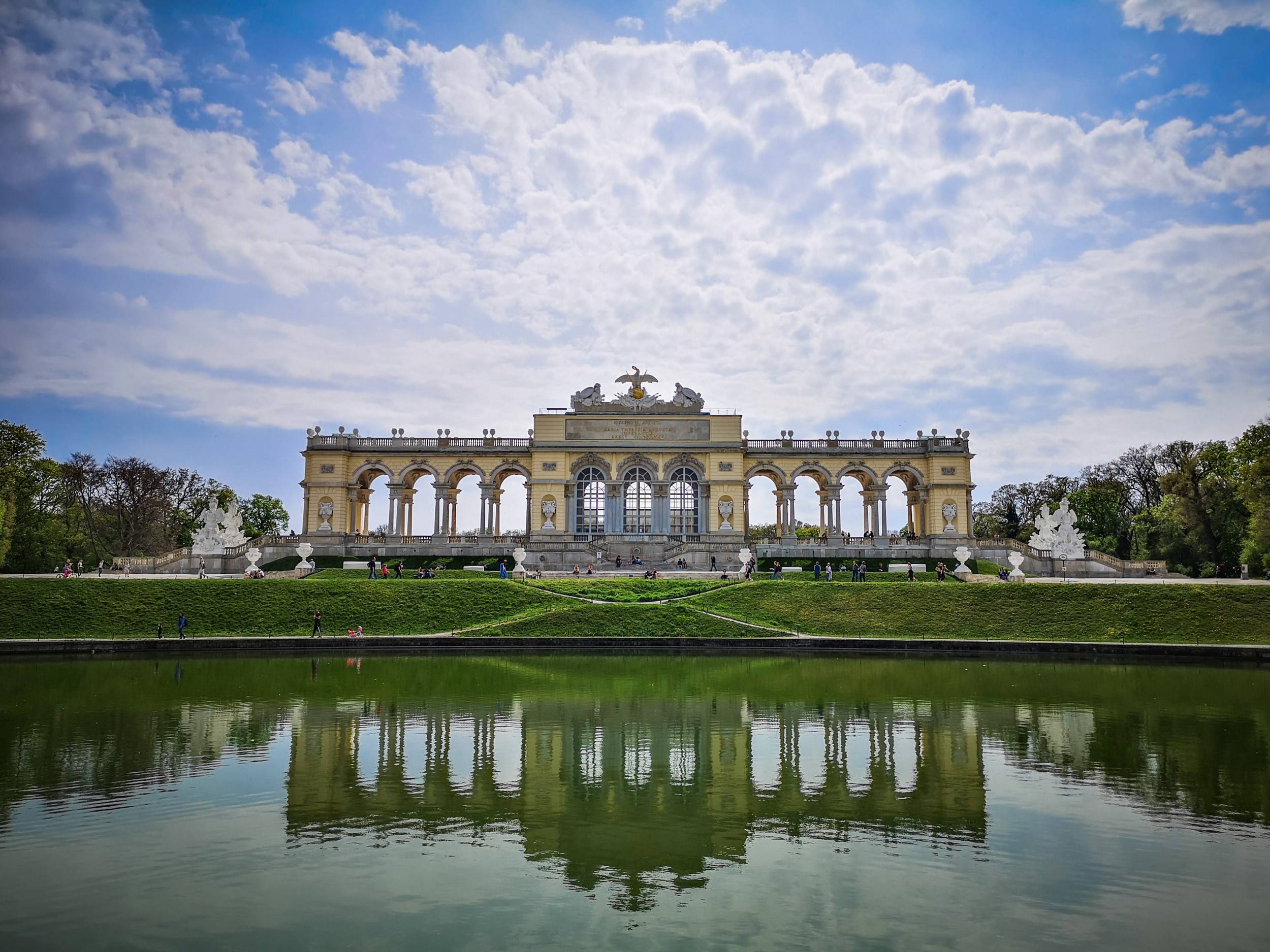
The Gloriette looks like a triumphal arc on steroids. Photo by Alis Monte [CC BY-SA 4.0], via Connecting the Dots
To this day the Gloriette sparks awe to Schönbrunn visitors, it certainly does to me. The center part of the Gloriette is built to remind a triumphal arc with rows of columns, forming semi-circular arches. Maria Theresa ordered the Gloriette to be constructed using the material from the Renaissance palace of Neugebäude – never-finished mansion under the rule of the Holy Emperor Maximilian II in 1568.
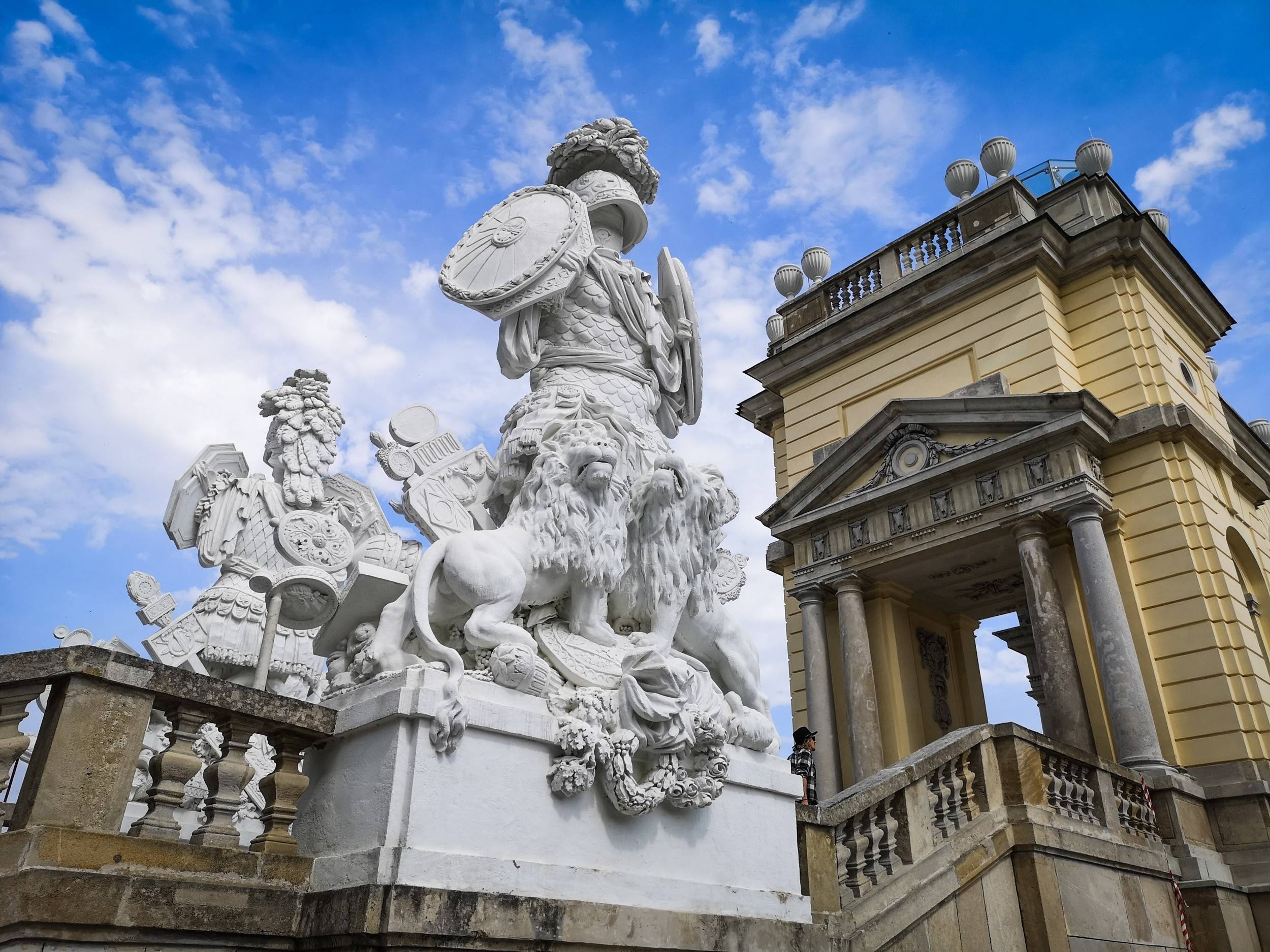
A half of the Gloriette was bombed during WWII and had to be rebuilt. Photo by Alis Monte [CC BY-SA 4.0], via Connecting the Dots
The eagle on the top of the Gloriette is the central motif of the monument. Not only it is on the Austrian Coat of Arms but also the symbol of both the Roman Republic and Empire. Many decorations of the Gloriette show various trophies of the Empire, highlighting the wealth of it. During World War II, the eastern part of it was destroyed by a bomb but soon was rebuilt after the war. Ever since it stands with pride, continuing the legacy of Schönbrunn and the Empire’s rich past.

The Great Parterre is an open area between The Gloriette, the Great Parterre & Schönbrunn Palace and the Neptune Fountain. Photo by Alis Monte [CC BY-SA 4.0], via Connecting the Dots
The Obelisk Fountain (1777)
Like many other monuments found across The Schönbrunn Gardens, The Obelisk Fountain was designed by Austrian architect Johann Ferdinand Hetzendorf von Hohenberg. The monument is done so well that it wouldn’t surprise me if, to a regular eye, the obelisk is raising a question whatever it was taken straight from Egypt. Of course, that is not the case, the hieroglyphs on obelisk are purported to tell the history of the House of Habsburg. In fact, even the writings on it are all made-up. Egyptian hieroglyphs were deciphered only in 1822.
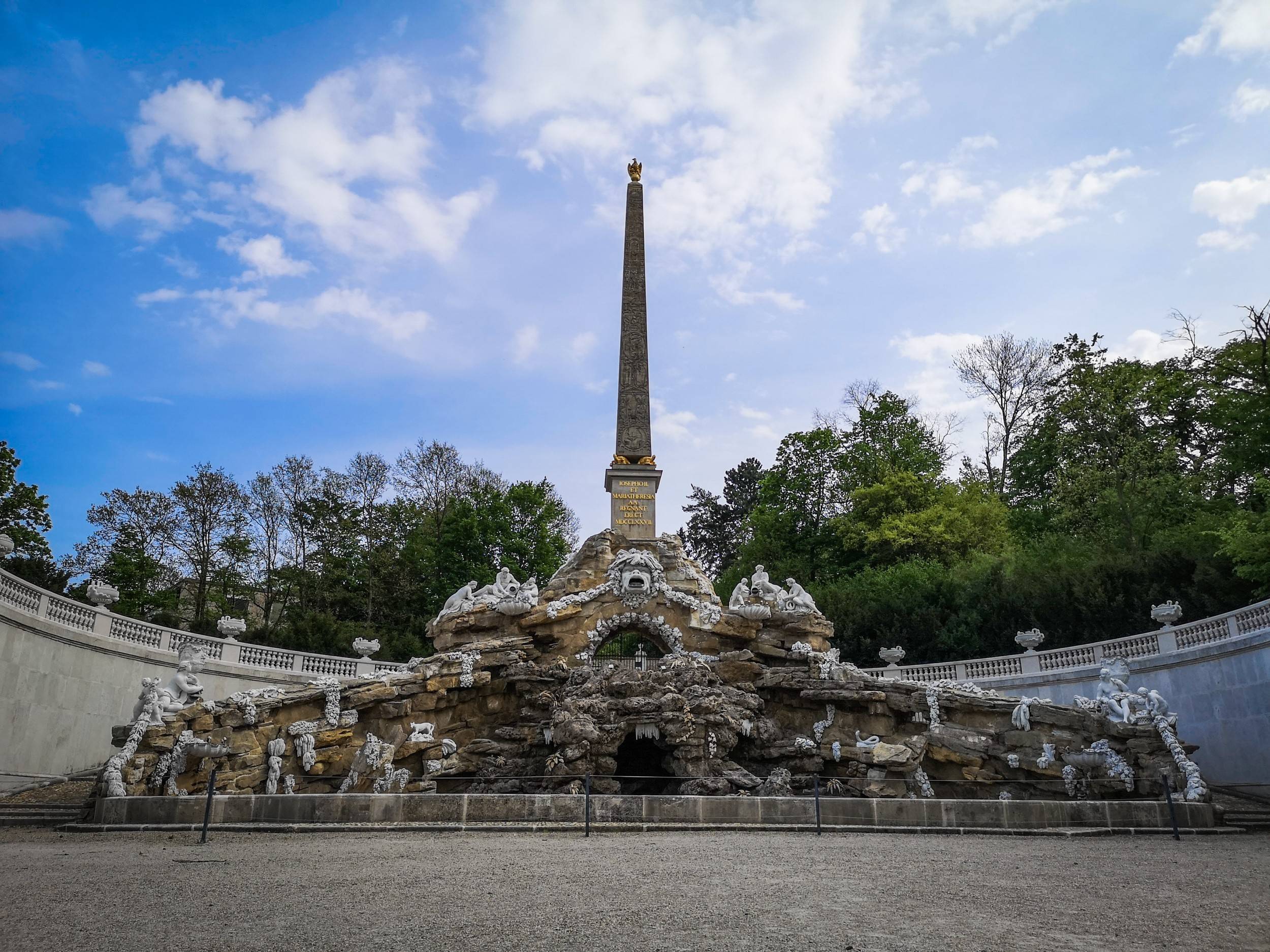
The Obelisk Fountain of Schönbrunn Palace Gardens. Photo by Alis Monte [CC BY-SA 4.0], via Connecting the Dots
Nevertheless, the symbolism of the design is clear and that alone proves that people of that time understood the archaic cultures better than we do now. An obelisk in Egyptian culture was associated with the Sun, depicted as a ray of light reaching the Earth. Schönbrunn Obelisk stands on four turtles, which represents stability of the structure and together with the four edges of the obelisk – the four directions of the world. The eagle on the top is the mediator between the Earth and Heavens, and only the House of Habsburg, represented by The Obelisk, can reach it.
Below the obelisk is a grotto, with people and other earth creatures. It depicts the land upon which the rule of Habsburg is absolute and righteous, as only they can reach the Heavens and transcend its message to the Earth. All of this in one monument.
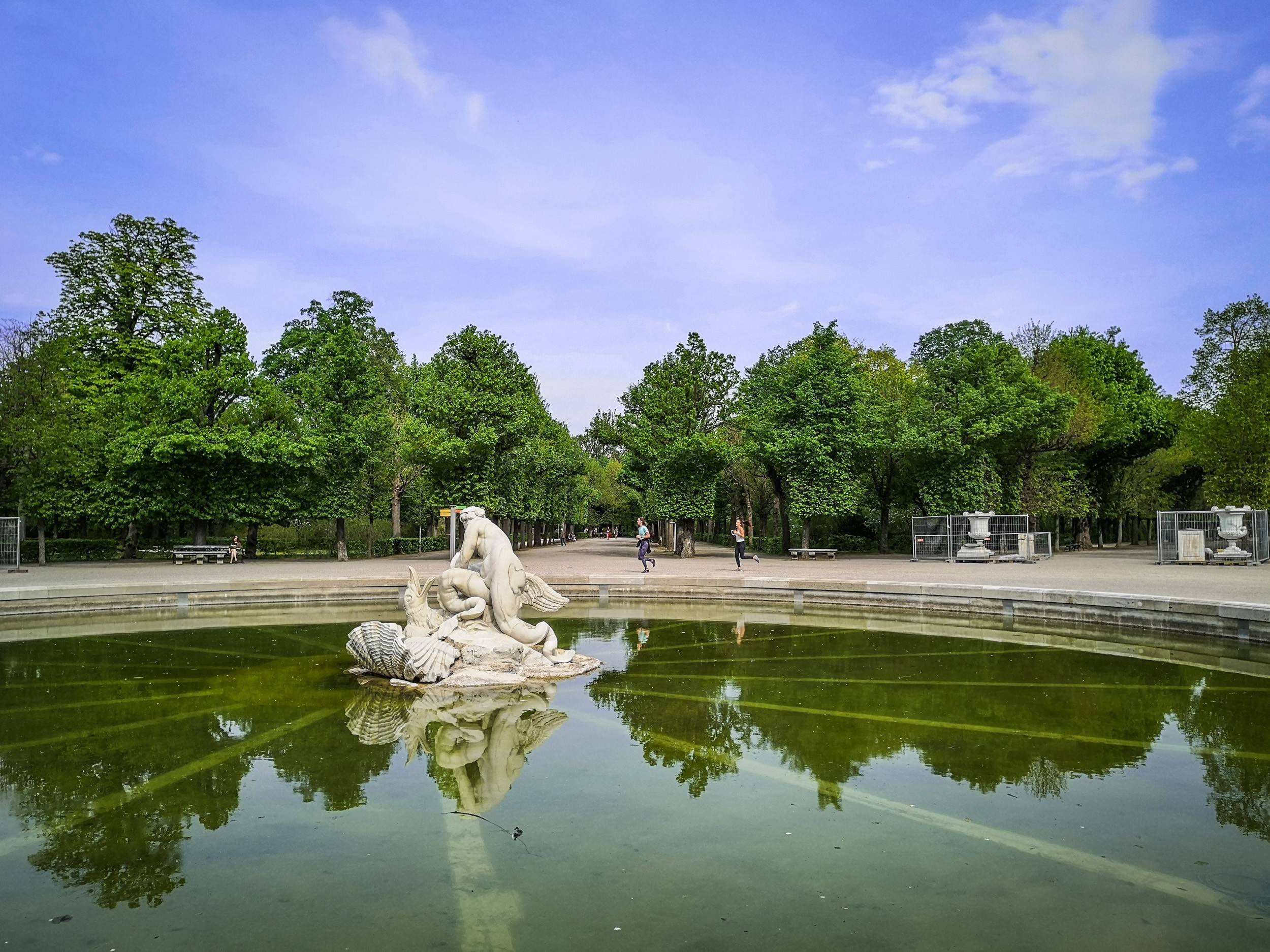
The intersections of stelliform systems of avenues on each side of Schönbrunn are decorated with the Naiad Fountains. Photo by Alis Monte [CC BY-SA 4.0], via Connecting the Dots
The Roman Ruins (1778)
Roman ruins around Vienna are not so uncommon. After all, Danube was the border of the Roman Empire and Vienna was founded as a Roman garrison in 1st century AD. Nevertheless the Roman Ruins found in Schönbrunn is not much more than just a monument typical of Romanticism era. In the mid 18th century everybody started looking back to the ancient lost empires and the preservation of its heroic past.

Originally, the Roman Ruins was known as Ruins of Carthage. Photo by Alis Monte [CC BY-SA 4.0], via Connecting the Dots
Despite these remains becoming actual wreck before its recent restoration, these Roman ruins are not real. Having said that, no such imitation could be done so well without any truth in it. It is told that Johann Ferdinand Hetzendorf von Hohenberg designed this monument based on the model of the Ancient Roman temple of Vespasian and Titus, excavated in 1756 by Giovanni Battista Piranesi in Rome.
The center figures are representing river-gods of Danube and Enns, which localize the Roman Ruins to the territory of Austria. Second to these statues, lies the sculptures of Hellenic heroes like Hercules fighting Cerberus and Vices with defeated Hydra. What it all means, it is hard to say. Symbols are not suited for a straight answer but it must be along the lines of indicating that Viennese dominion stands on the foundation of the Hellenic cultures. As the German-Roman Emperors, the House of Habsburg saw themselves as the legitimate successors of the ancient Roman Empire.
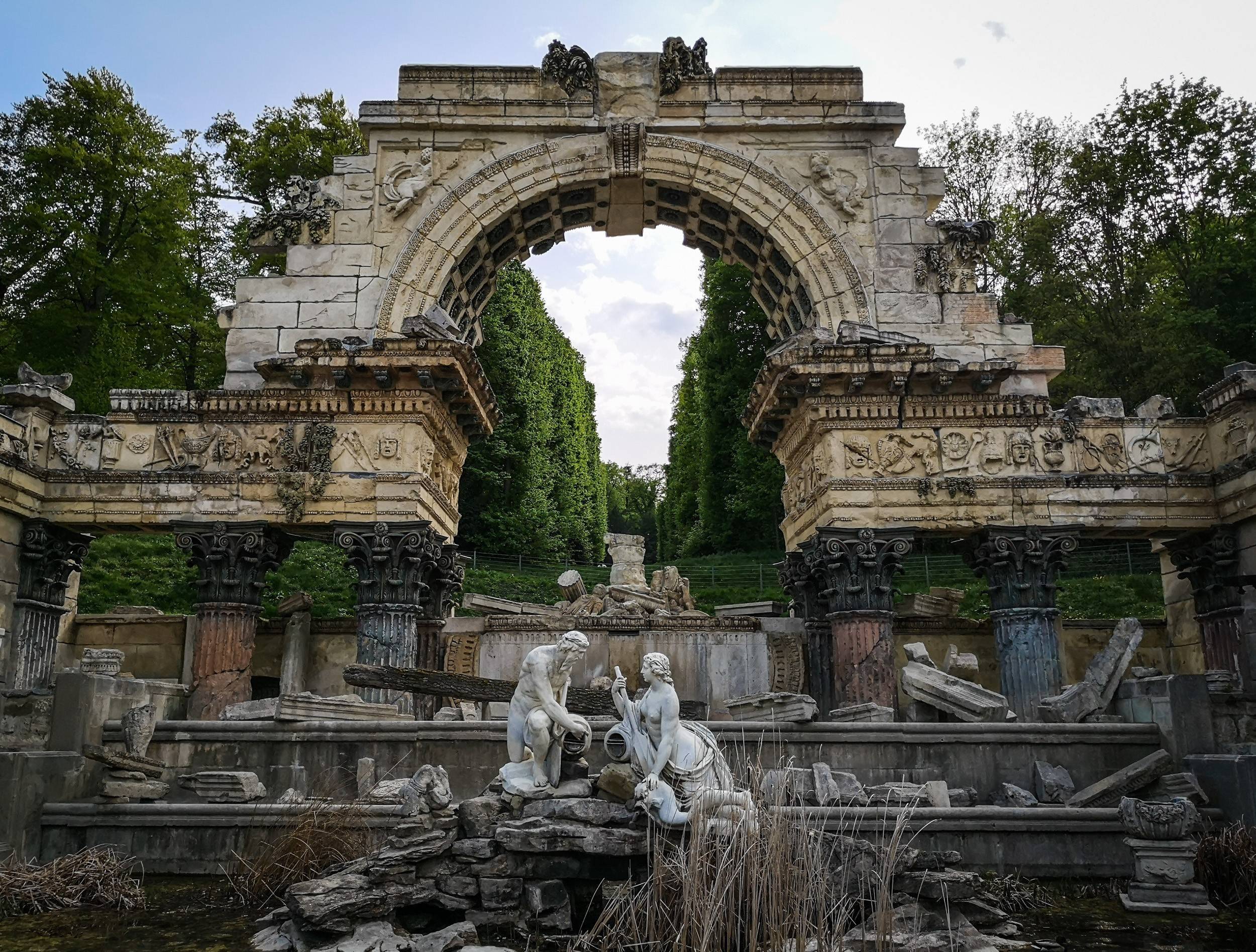
At the center of the Roman Ruins are the river-gods of Danube and Enns. Photo by Alis Monte [CC BY-SA 4.0], via Connecting the Dots
Maybe it was known as the Ruins of Carthage because it is the Carthage, which is in ruins and Roman Empire is still present, here in Austria.
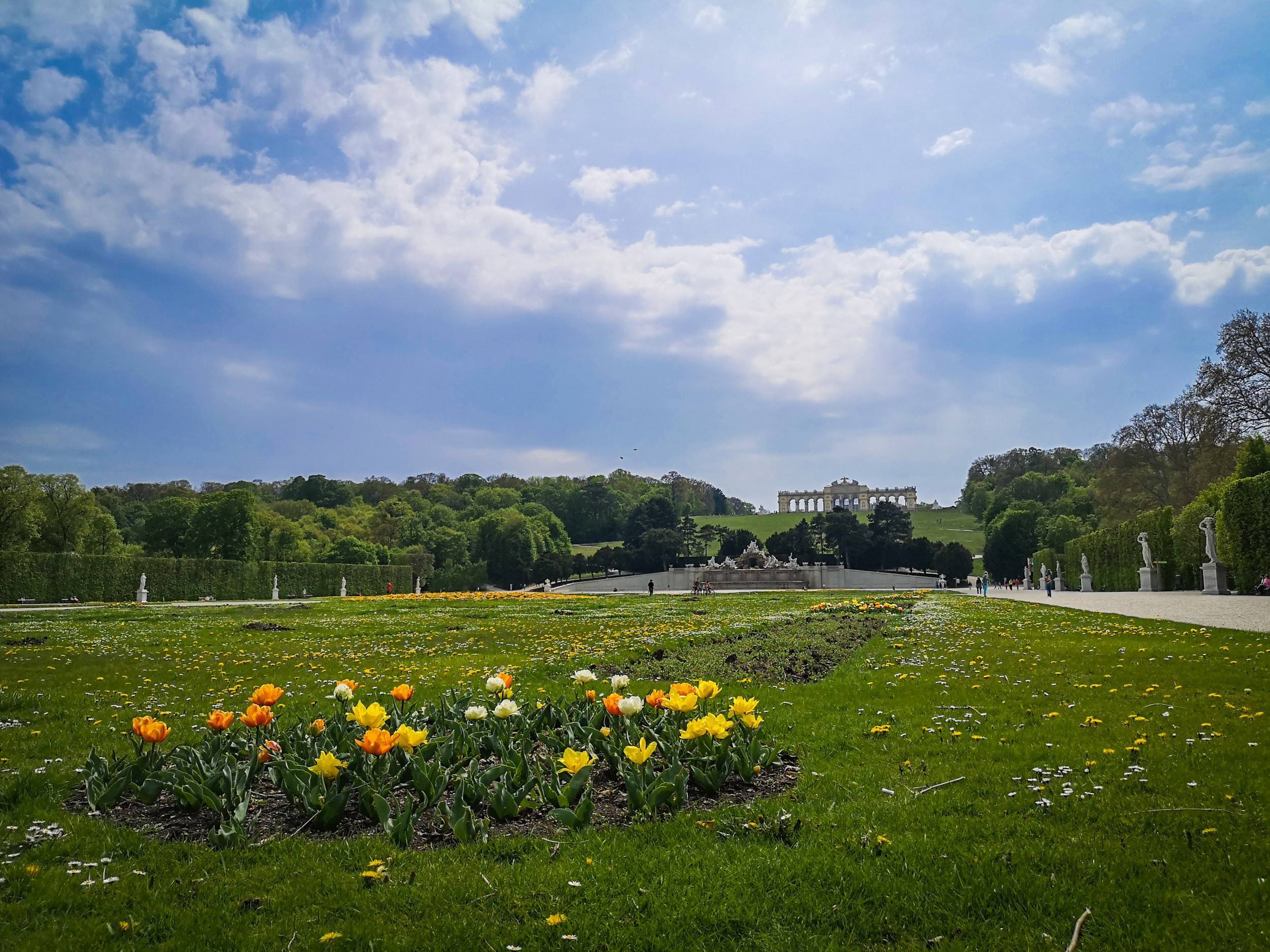
The Great Parterre will surprise with its size. Photo by Alis Monte [CC BY-SA 4.0], via Connecting the Dots
The Great Parterre and Neptune Fountain (1776-1780)
According to the principles of Baroque, in the same manner, as in architecture, gardens horticulture was an expression of the status of imperial authority. The Great Parterre is the biggest open space in the whole area of Schönbrunn gardens and nowhere else the richness and artisan precision is as obvious as it is here. The whole setting of the Great Parterre, combined with The Neptune Fountain and The Gloriette could be called the crown jewel of the crown jewel of the Empire.
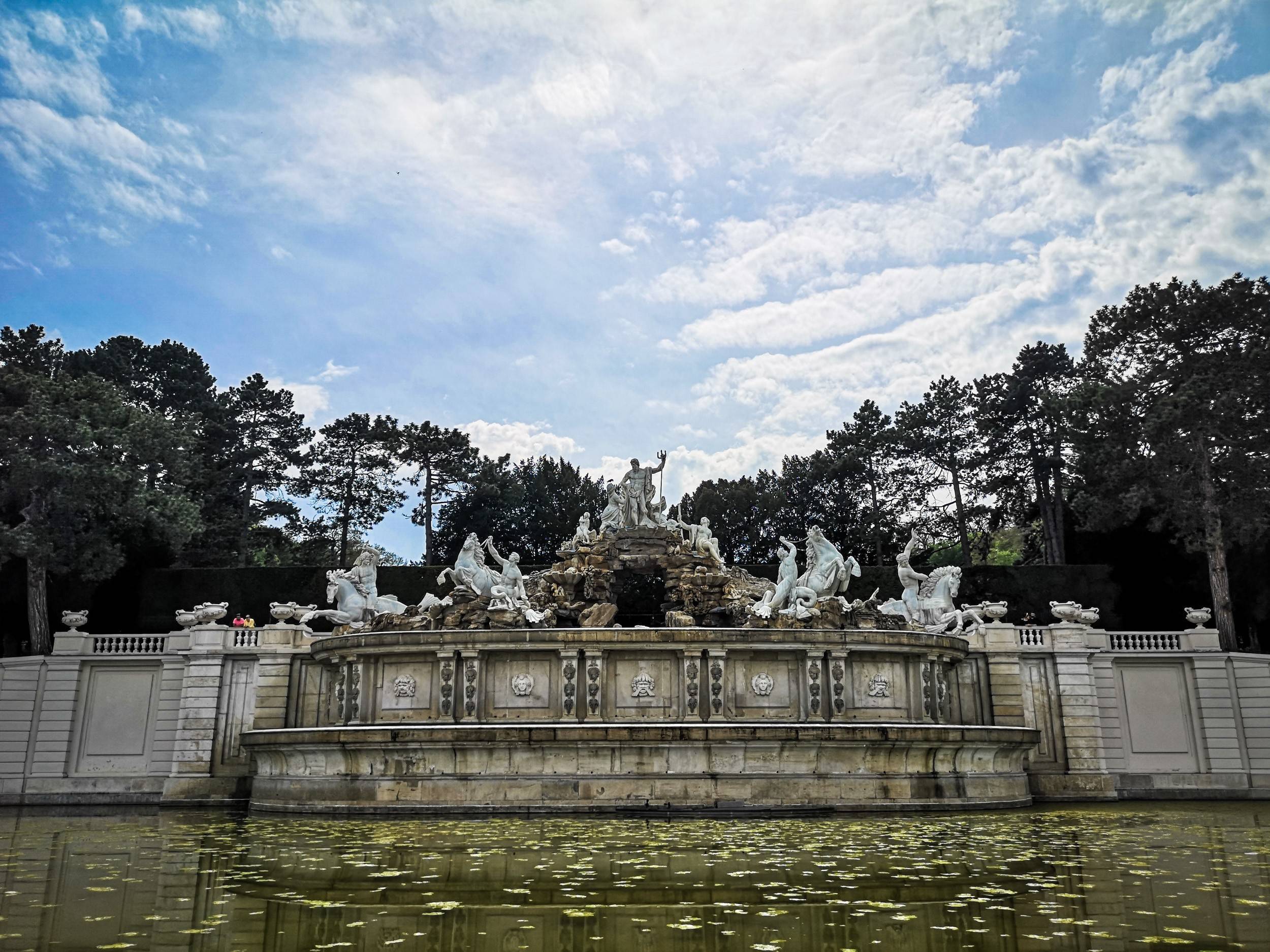
At the center of statue – the sea-goddess Thetis pleading to sea-god Neptune. Photo by Alis Monte [CC BY-SA 4.0], via Connecting the Dots
What remains a mystery to me is the choice of the fountain. Neptune, surrounded by his entourage are the clear symbols and patrons of the sea. Whichever empire was ruled from Vienna was more or less land-locked, or, at least, considered not to be a naval super-power.
Maybe the whole point of it lies within the details? In the center of it, just next to Neptune, is the sea-goddess Thetis. She is entreating Neptune in order to get his sympathies for the voyage of her son, Achilles. Maybe the Neptune Fountain was Maria Theresa’s tribute to the God of seas, asking to favor her Empire in the seas?

It took decade to complete the full complex of the Great Parterre. Photo by Alis Monte [CC BY-SA 4.0], via Connecting the Dots
Schönbrunn Public Gardens (1779)
Schönbrunn Palace and its gardens wouldn’t be in the beautiful shape it is if it was not so for the women of the House of Habsburg. It shouldn’t be surprising. If you want something beautiful this big and every inch of it – leave it to women. The results are as beautiful as Schönbrunn is.
The most notable impact to Schönbrunn of all of them had Maria Theresa. Throughout her life she showed a special interest in the palace and together with ingenious architects, she greatly improved the designs of the palace and gardens.
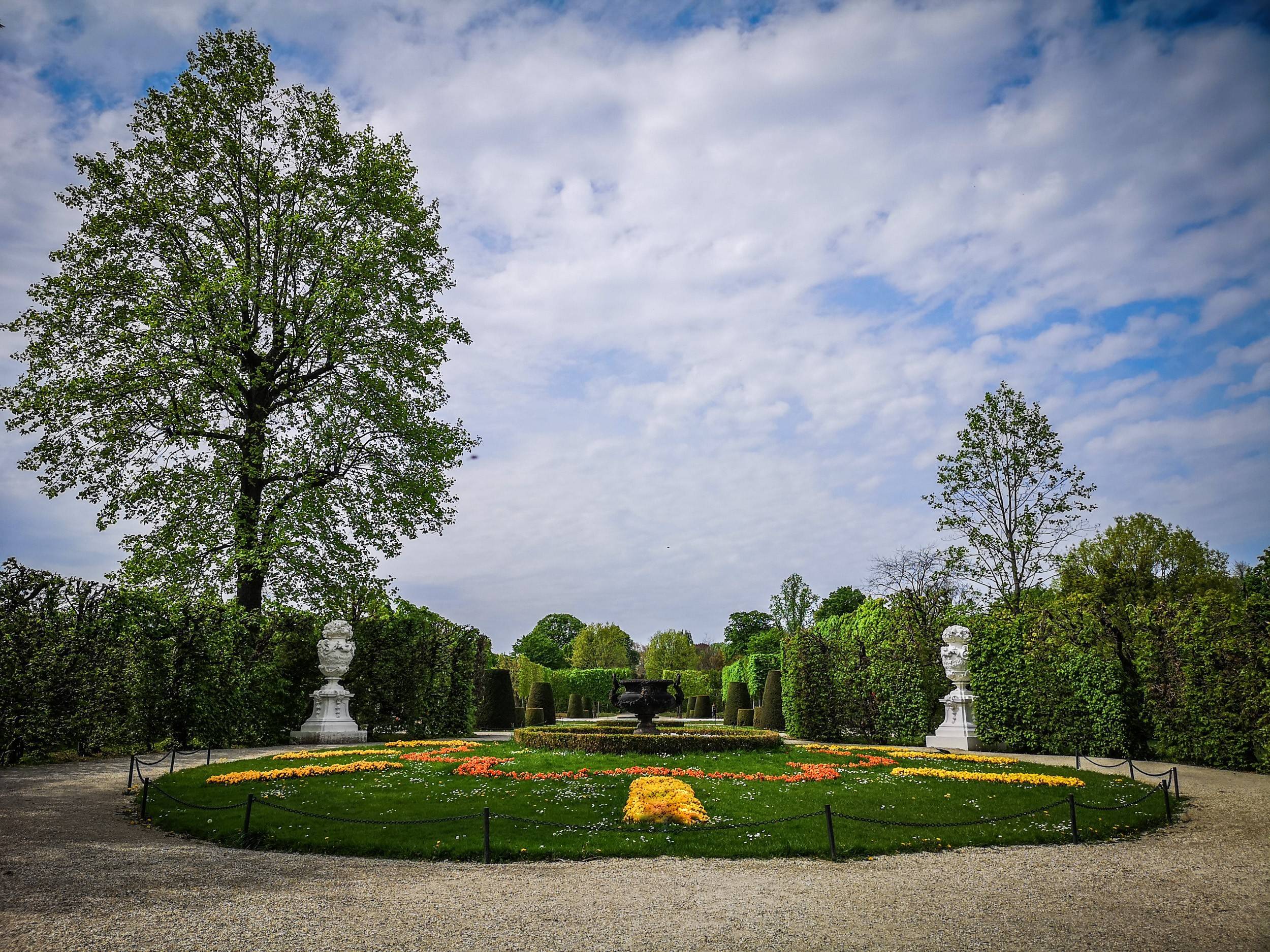
The complexity of the gardens displayed the status of the authority. Schönbrunn Gardens are very very complex.. Photo by Alis Monte [CC BY-SA 4.0], via Connecting the Dots
Schönbrunn Palace Gardens were open to the public in 1779, just before Maria Theresa’s death. If nothing Schönbrunn is the legacy of Empress Maria Theresa, the last of House of Habsburg.
The gardens have everything that art has ever created. – Johann Edler von Kurzböck, 1779
My Impressions of Schönbrunn Palace and its Gardens
First and foremost, I have to note that I’m not a big fan of such places. Just because it is history now, I can dismiss the fact that such places of luxury and brilliance would be impossible without exploitation of people. What I dislike is the way people seem to approach this stature of luxury; Or rather how it affects them. Like they deserve this. I doubt any of them understand what it means. There is a price to pay for it.
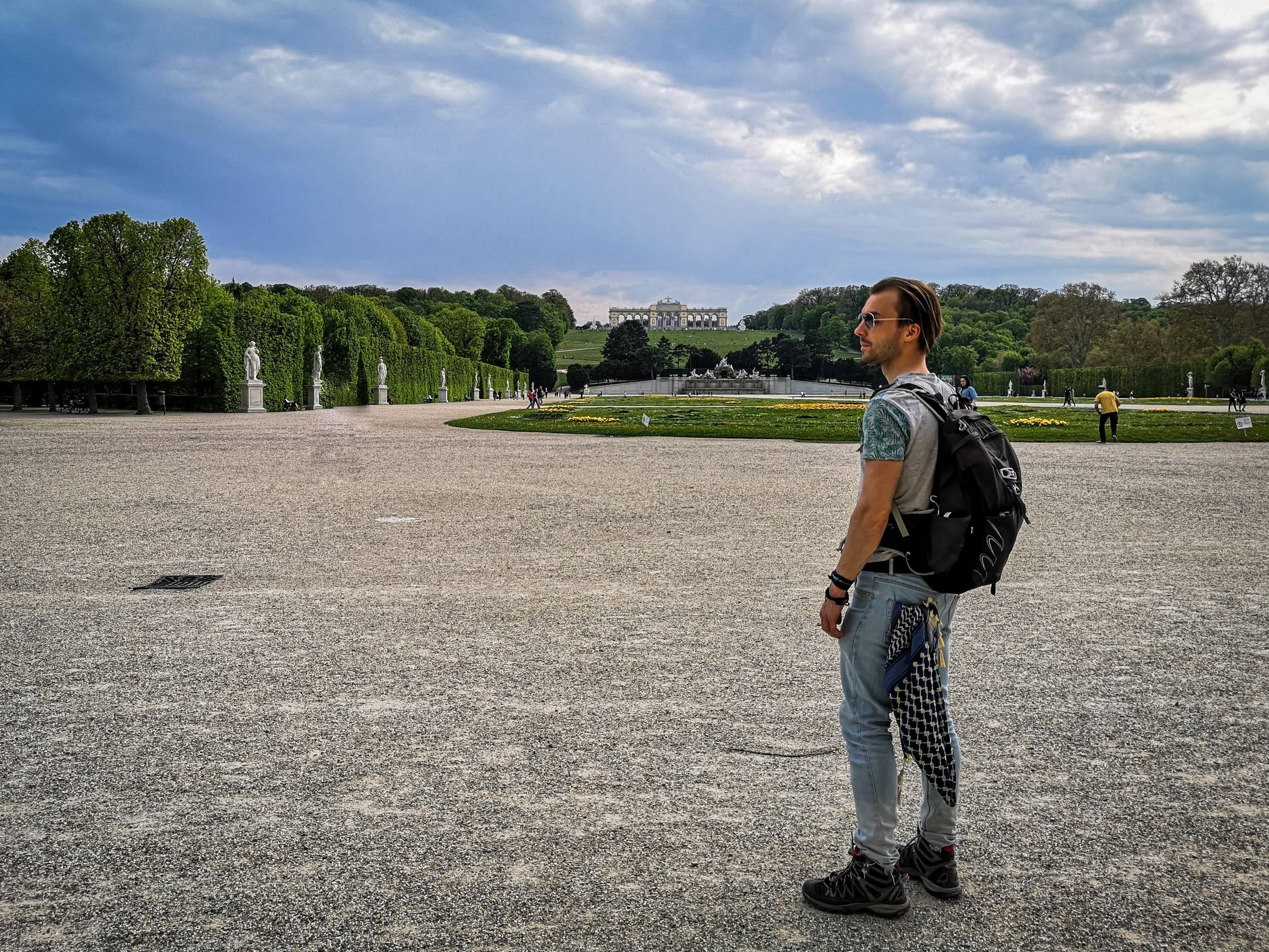
Standing in the Great Parterre – the largest space in the gardens. Photo by A.L. [CC BY-SA 4.0], via Connecting the Dots
Having said that, I have nothing but positive experiences after my second visit to Schönbrunn and all the readings I’ve done about it. At first, I disliked the whole idea of the continuation of the Roman Empire but once I understood its respect for the Hellenic art and tradition, I changed my mind.
Similarly with Schönbrunn. Despite the undeniable beauty of the Palace and its Gardens, the park is full of interesting stories and surprises. This makes Schönbrunn a must-visit in Vienna and I highly recommend spending at least a day in the gardens. Only with time, they start to reveal the secrets and rich history of Schönbrunn.
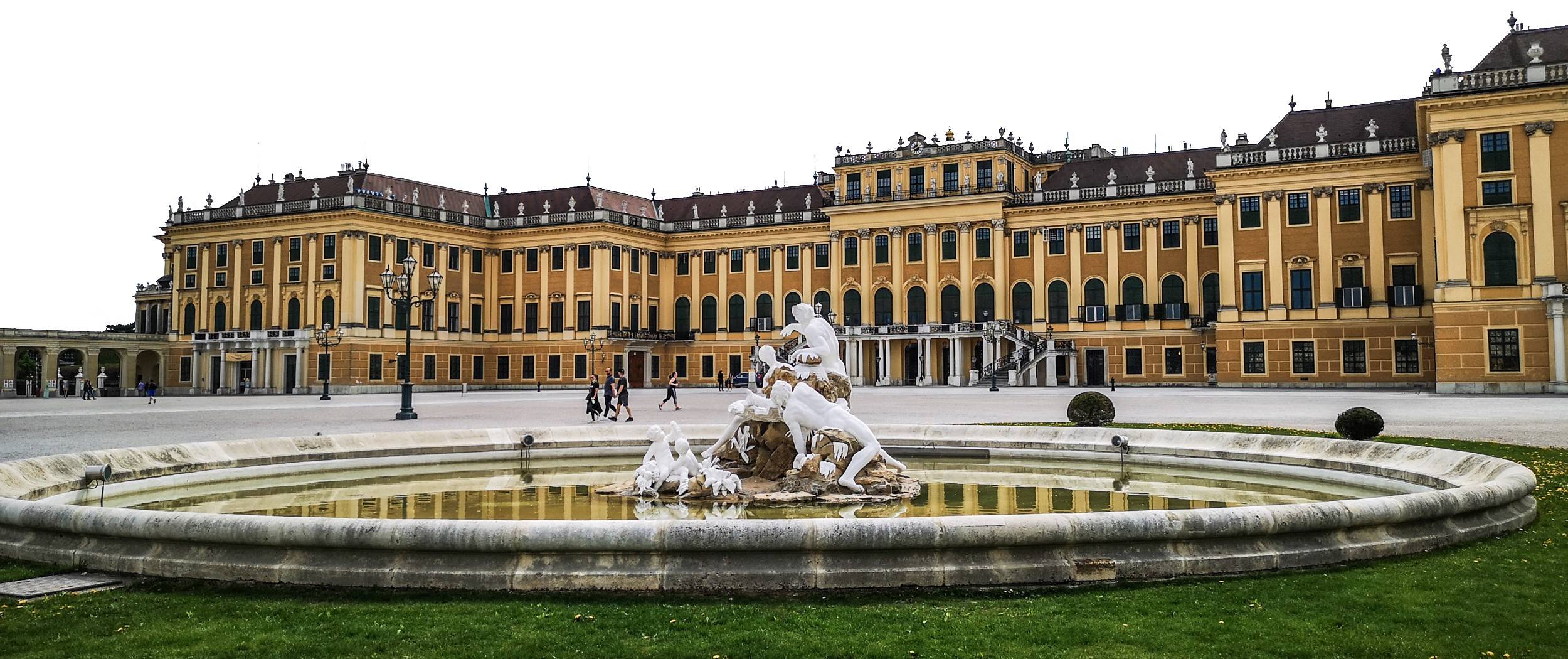
Ehrenhof fountain of Schönbrunn Palace. Photo by Alis Monte [CC BY-SA 4.0], via Connecting the Dots